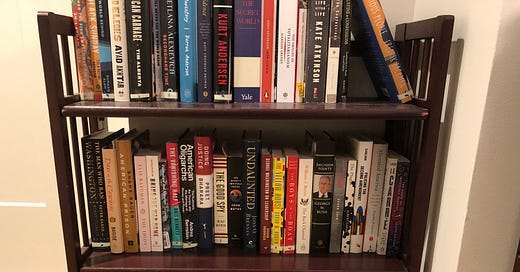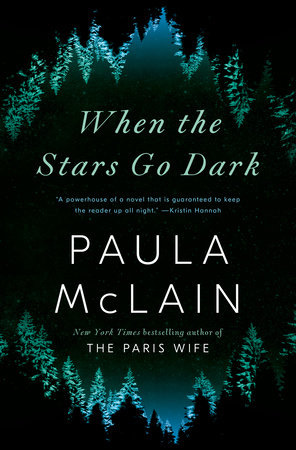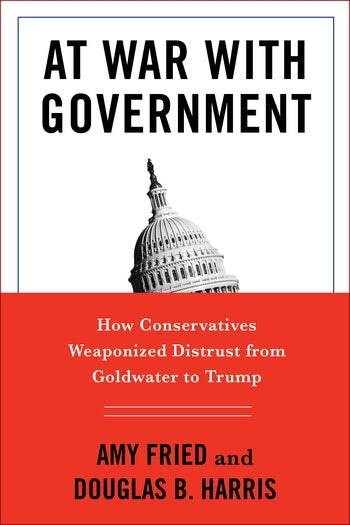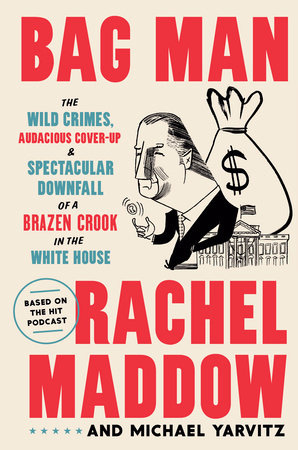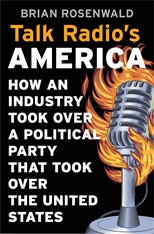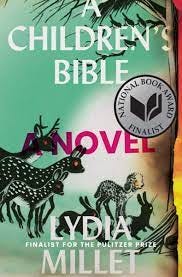Welcome to the April 2021 Reading Round-Up. Each month, I write about the books I read and rank them from worst to best. If you need a refresher on my rating system, you can find that here.
This month I read nine books, six fiction and three nonfiction. My reading this month was quick to start with a series of good fiction reads, but it slowed as I waded into heavier books about conservative media and politics. There are a lot of good books in the mix so I hope you find something that you want to pick up.
9. When the Stars Go Dark - Paula McLain
Fiction/Mystery/Police Procedural, 384 pages
On the surface, When the Stars Go Dark is a story of the search for Cameron Curtis, a missing child in Mendocino, California. But the book, equal parts police procedural and mystery, is about more than the disappearance of Cameron. When The Stars Go Dark is centered around Anna Hart, a deeply flawed detective who is drawn to Cameron’s case after fleeing her own personal tragedies. Anna is dedicated to every missing persons case she is assigned and feels a sense of solidarity with all of the victims she interacts with. At times this empathy veers closer to the clinical, when McLain uses Anna’s voice to explain the psychological characteristics that victims and their abusers exhibit. However, Anna’s empathy and overlaid expertise also explain her drive, which almost single-handedly propels her investigation and personal healing forward.
The book’s pace picks up in the final quarter, as the clues start falling into place for Anna and the mystery is slowly solved. As the answers to Cameron Curtis’ case are revealed, so too are the answers as to why Anna has fled to Mendocino in the first place. McLain is a talented writer who uses the distinct nature and setting of the California village to her advantage in creating a dark ambiance for the different moments in her book. The pages turn quicker as the book draws to a close, and readers can’t help but root for Anna’s success and safety. However, Anna’s personal healing journey has a deus ex machina feel to it when, instead of discovering that she has acquired the tools to heal on her own, a local psychic provides her the absolution that she needs to forgive herself, tying the plot up in an almost neat bow.
Overall, this was a propulsive read that explored how personal trauma can live with and motivate a person’s behavior with mixed consequences. For people who enjoy true-crime or mysteries, you will not be disappointed with McLain’s latest release.
Rating: 7/10
Thank you to Penguin Random House for the advanced review copy of this book.
8. Pizza Girl - Jean Kyoung Frazier
Fiction, coming of age story, 208 pages
Pizza Girl is a coming of age novel about a pregnant 18-year-old working at a pizzeria while she comes to terms with her identity and life. The main character, whose story is told in the first person and who is referred to ubiquitously as just “Pizza Girl,” works at the pizza store with no clear idea of what she wants the future to look like. One day, a customer calls in asking if the store sells pizza with pickles, introducing Pizza Girl to Jenny, a 30-something-years-old mother also struggling to figure out her sense of place. Along the way, she develops an obsession with Jenny, who she wrongly views as someone who can provide her with a more interesting life.
Pizza Girl spends some time, but not much, grappling with her pregnancy and impending status as a mother. For the most part, she treats her pregnancy as an inevitable and uneventful next step in her life, and is often more concerned with her deteriorating relationship with her boyfriend, how to properly grieve and remember her recently deceased alcoholic father, and how to develop her own identity. The book’s largest strength comes from the author’s talent in diligently crafting an authentic personality for a young adult treading water and unsure of how to move forward.
Rating: 7.5/10
7. Super Host - Kate Russo
Fiction, 368 pages
Bennett, the main character of Super Host, used to be a successful artist but lately his career has stalled. His wife cheated on him and then moved to America with her new spouse and his daughter has moved into central London for college. Struggling financially, Bennett decides to rent his West London house on Airbnb while living in his studio in the backyard. Russo adeptly weaves together the stories of Bennett and three guests that stay in his property. While the chapters featuring each guest are one and done, Bennett’s story continues throughout the book and readers watch as his life evolves. Russo is a skilled writer and is able to create characters with depth, despite their varied prominence in the narrative. This book was marketed as a sweet story that would make readers smile, but I found many elements of it deeply sad. There is no doubt that Bennett is likable and I did root for him, however, his life is also moderately depressing and so are the stories of each of the guests that stay in his house. Despite this, I enjoyed the book for the detailed portraits Russo paints of her characters as well as the nuanced descriptions she provides for different neighborhoods in London.
Rating: 7.5/10
6. The Ex Talk - Rachel Lynn Solomon
Fiction/Romance, 354 Pages
The Ex Talk is set in the Seattle public radio station where the main characters, producer Shay Goldstein and journalist Dominic Yun, work. With the station struggling financially, Shay and Dominic’s boss put them together to host a new radio show about the nuances of relationships. The show is marketed as having two exes host, despite the fact that Shay and Dominic have never dated. As this is a romance, the outcome of this “haters become lovers” plot line is inevitable, as well as the public drama that unfolds when fans find out that the premise of the show was a ruse. What is not inevitable, however, is the interesting take that Solomon provides on public radio as well as power and gender dynamics in the workplace as Shay, a ten year veteran of the station, struggles to have her input and presence respected. Fans of NPR will find lots of relatable references that make this light read one with an unusual amount of substance. The Ex Talk is cheery and warm, which is sometimes exactly the type of book that you need.
Rating: 8/10
5. At War With Government - Amy Fried and Douglas B. Harris
American politics and governance, 320 pages, release date: August 3, 2021
This book is an interesting, informative, and alarming study of the way that popular distrust in government has been wielded by Republican politicians to gain and maintain political power. Fried and Harris trace the origins of anti-government sentiment to the founding of the United States, writing about the government skepticism that underpinned the American revolution and the way that this skepticism manifested itself in the foundational pillars of American democracy. While Fried and Harris quickly trace the history of this distrust through the present, the bulk of the analysis occurs from the Reagan era onward, with detailed chapters laying out the ways that Republican lawmakers used their positions of power, or lack thereof, to stoke distrust in government as a way to further political objectives. Fried and Harris are clear in their argument that there is nothing inherent in the Republican party platform or principles that should make stoking government distrust inevitable. Instead, it was political actors within the Republican party who utilized often hypocritical and contradictory political opportunism to exploit some of the worst impulses of a subset of Americans for personal political gain.
In addition to writing about the ways that leaders in the Republican party harnessed distrust to advance political objectives, the authors also discuss the logical end for which skepticism in government ultimately manifests itself. Fried and Harris make the compelling argument that stoking suspicion towards the American government is a short-term solution to win elections. Over the long term, distrust not only makes it impossible to govern, but also creates a never ending feedback loop. Moderate conservatives willing to compromise are targeted and primaried out of office, but without super majorities, an absence of compromises makes it impossible to legislate and improve people's lives. Without legislation, there is little to run a campaign on other than an anti-government screed. Although mentioned a few times in passing, I think the book would have benefited from a deeper analysis of the role of right wing media in fueling the flames of distrust. In particular, an emphasis on talk radio may have added an additional explanation for the rise and spread of government suspicion given the parallel timelines of the proliferation of talk radio popularity and the Reagan era.
The book concludes with an assessment of how far the politics of distrust have taken the country. Whereas in the Clinton era, anti-government messages promoted by the right stopped the passage of comprehensive health care legislation, today, the messages of distrust promulgated by Donald Trump and the Republican Party directly contributed to an insurrection. In discussing these events, the authors are quick to point out a central argument they have been making all along: promoting government suspicion may be convenient, but those who spread it can not control it forever, serving an ultimate harm to democracy when it inevitably spirals out of control. I recommend this book for anyone interested in learning more about the state of American politics and the way that a political party in the United States government gains power by railing against the institutions it works within.
Rating: 8/10
Thank you to Columbia University Press for the advanced review copy of this book.
4. Bag Man - Rachel Maddow and Michael Yarvitz
Non-Fiction/History, American politics and governance, 304 pages
Bag Man tells the story of the investigation and prosecution of Vice President Spiro Agnew for corruption. Although these events take place at the height of Watergate, Agnew was involved in his own separate scandals. Indeed, because of the acrimony between Nixon and Agnew, Agnew was one of the few high level officials in the Nixon administration who is able to claim a lack of involvement. The Watergate era added a heightened level of importance to Agnew’s corruption because of the urgency that federal prosecutors had in indicting Agnew so that he would not be next in line to the presidency after the expected Nixon impeachment.
One of the more interesting elements of the book was the unstated parallels and precedent set for future corruption in the executive branch. The 1973 Office of Legal Counsel’s report that stated that presidents could be neither investigated nor indicted while in office was made explicitly at the behest of Nixon to serve Nixon’s interests. Yet, this report continues to serve as a hard legal doctrine that guided the outcome of the Mueller Investigation in 2019. Agnew was also a rabid racist and anti-semite who used bigotry to rile up crowds and gain supporters who liked him for “telling it like it is.” In the same public appearances, Agnew was known for labeling the media and the Justice Department as enemies and encouraging his supporters to see these institutions through the same suspicious lens.
The clear parallels between the story of Agnew and the Trump era raise important questions about how institutions are reliant on good actors within government who refuse to bow to pressure from bad actors. If federal prosecutors had not been as dogged as they were in their investigation and if Attorney General Richardson had not been supportive of the proceedings, it is very likely that Agnew, a man taking bribes from his office, would have become president once Nixon resigned. The lessons learned from Agnew’s story serve as an interesting and terrifying lesson that can be carried forth into our present.
Rating: 8/10
3. Talk Radio’s America - Brian Rosenwald
Non-Fiction, American politics/conservative media, 347 pages
This was an incredibly interesting exploration of an industry that I previously knew very little about, but which clearly has had an outsized impact on the direction of the Republican party, partisan polarization, and American politics generally. Following the repeal of the Fairness Doctrine in 1987, conservative talk radio sprang up around the country because it was found to be especially financially lucrative, giving a “voice to the voiceless” and standing up for people who believed themselves to be disaffected. As more competitors entered the market, “talkers,” as they are referred to in the industry, started spewing rhetoric farther and farther to the right with the hope of keeping listeners engaged and the money flowing. This cycle, however, has problems in its practical application to elections and politics. As the power and audience reach of talk radio personalities (and later cable TV channels like Fox News) grew, Republican politicians began shifting farther to the right to appeal to the voters within the conservative media audience who were galvanized to vote in elections. As discussed in At War With Government, moderates unwilling to conform with the ideas promoted in conservative media were either defeated in primary challenges or became unwilling to compromise and thus shifted father to the right.
Rosenwald makes a strong argument for the adverse impacts conservative talk radio has had and continues to have on American democracy. The talk radio industry holds extraordinary influence with the Republican electorate and by extension leaders of the Republican party, yet Rosenwald argues that the industry is almost exclusively centered around financial gain. These two realities are inherently incompatible. Talk radio hosts and Fox News personalities peddle sensationalized information meant to maintain an audience and in turn the audience lobbies their elected officials in myriad ways to act more like their favorite media talking head. There is no stronger example then the rise of Donald Trump, a man who spoke like talk radio hosts and who supporters claimed were finally speaking out loud what they had been thinking, an instinct only validated by conservative media.
The repeal of the Fairness Doctrine and the subsequent rise of conservative talk radio also contributed to the creation of information silos where listeners never have to hear an opposing point of view and their beliefs are always validated. Democrats, like Bill Clinton, tried to engage with the medium and provide another perspective, but have almost completely given up as appearances on shows became consistently adversarial. And yet, without Democratic engagement with conservative media to provide another side of the story, the gulf of polarization only widened and continues to expand.
Rating: 8/10
2. Finlay Donovan Is Killing It - Elle Cosimano
Fiction/Mystery, 368 pages
Finlay Donovan is Killing It is a propulsive, smart, and fast-paced read. Finlay Donovan is a financially struggling, recently divorced mother of two young kids. She is also a mystery writer. While at lunch with her editor pitching an idea for a new murder mystery that she was supposed to start months ago, Finlay gets slipped a note by the woman sitting next to them offering her $50,000 to kill her husband. While insistent that she does not want to get involved, Finlay can not keep her curiosity at bay and decides to inconspicuously meet the man she has been hired to kill. Once there, a series of mishaps create a snowball of events that plunges Finlay headfirst into the coverup of a murder at the same time that she is trying to solve it. Along the way, Finlay gets wrapped up in a police investigation and a run-in with the D.C. branch of the Russian mafia. While some elements of the mystery can sometimes feel a little convenient, overall the book is creative and crisp. Cosimano adeptly pulls in little details that would normally be ignored by the reader to tie the mystery together and has created funny and charming characters that makes this book hard to put down.
Rating: 8.5/10
Side note: people who enjoyed watching Dead to Me on Netflix will enjoy this book!
1. A Children’s Bible - Lydia Millet
Fiction, 224 pages
There was so much packed into the 224 pages of this book, including warnings about the prescient nature of climate change and commentary on parenthood and growing up. A Children’s Bible takes place in the present and opens at a large vacation home in New England where old college friends have gathered with their kids. However, the reunion quickly goes awry when a massive storm hits the area, cutting off electricity, causing catastrophic physical damage, and ushering in anarchy. Throughout the disaster the adults are either drunk or incapable of taking charge, leaving the children to fend for themselves. The story is told through the perspective of one of the children (who is more of a young adult), but also through the collective lens of youth in general. The big take away of the book is that the planet is slated for destruction because the parents, i.e. adults or people with power, have been and continue to live their lives in the blissful stupor of denial and are incapable of stepping up to stop climate change. It is only the kids, i.e. the next generation, who realize their plight. It is through this acknowledgement that they have the gumption to take initiative in the face of crisis instead of having a complete psychotic breakdown like that of their parents. Sprinkled throughout are lots of references to the bible, which would certainly add a layer of depth for someone who is generally familiar with biblical parables.
If I’m being honest, this book completely freaked me out. It is a terrifying story in its depiction of a reality that our society is trying to deny. However, Millet’s writing is exceptional and the story stayed with me long after I was finished. It is for that reason that this book was the best that I read this month.
Rating: 9/10
If you like what I’ve written or want to see more reviews, recommendations, and round-ups about a wide range of novels, histories, and more, consider subscribing now by entering your email. It’s free and it’s about books. What’s not to like?
Want to see last month’s round up? You can find that here.

